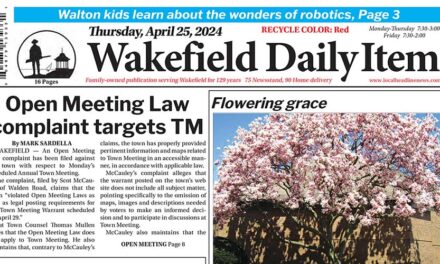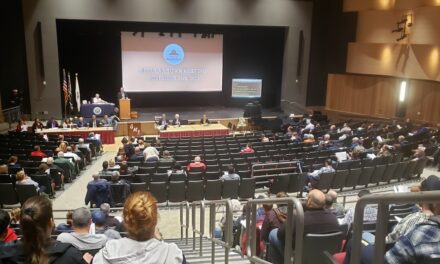Published in the March 4, 2016 edition.
By MARK SARDELLA
WAKEFIELD — The Conservation Commission wants time to make a site visit to 94 Butler Ave. before it decides whether it will consider a compromise proposal from a developer regarding where the wetland boundary should be set.
Town Counsel Thomas Mullen announced after an hour-long executive session with the ConCom last night that commissioners would like to visit the site on March 12 and provide an answer at their March 17 meeting on whether they would consider the developer’s proposal.
Atty. Brian McGrail has been representing Mike Prousalis and Mike Zammitti of Woods, LLC related to an Abbreviated Notice of Resource Area Delineation (ANRAD). An ANRAD establishes the location of a wetland boundary, usually in advance of property development.
The bone of contention comes from the fact that the site was illegally filled in the early 1970s, an act that the Conservation Commission says altered the natural wetland and changed the location of the wetland boundary.
The illegal fill reportedly includes demolished remains of the Atwell Building of the old Wakefield High School on Main Street, which was destroyed by fire on Dec. 12, 1971. Testing has shown the fill material to contain concrete, rebar, brick, burnt wood, asphalt pieces, metal, ash, roofing shingles, tires and blue plastic to depths of 8-10 feet.
The Commission has taken the position that the wetland boundary should be set to where it would be if the area had never been filled. McGrail and his clients have argued that the wetland boundary delineation should reflect what exists today.
McGrail and his clients appealed the ConCom decision on the location of the wetland boundary and the Massachusetts Department of Environmental Protection (DEP) overturned the ConCom’s decision. The town and the Conservation Commission have now appealed the DEP’s ruling.
Mullen indicated last night that if the ConCom agrees that the developer’s proposal is worth pursuing, the DEP proceedings could be put on hold while the developer and the ConCom work toward an agreement. He said that the judge in the case wants an answer by Friday, April 1.
Prior to the executive session, Engineer Scott Cameron displayed plans and outlined the developer’s proposal to set the wetland boundary and provide some restoration of the wetland and upland areas. He also showed a proposed protected wildlife corridor and a retaining wall along the restored area.
After the ConCom emerged from executive session, Mullen acknowledged that McGrail and his clients believed that they had made a generous offer. However, he said that the Commission was not convinced from looking at the plans on paper. They wanted to look at the actual site in person before deciding if the proposed compromise was worth pursuing.
The Commission continued the hearing to its March 17 meeting.
—–
The ConCom approved the Wakefield Municipal Gas & Light Department’s plan for the installation of approximately 410 feet of 4-inch plastic natural gas distribution pipe on Water Street and under the Mill River.
Ken Stanley of Tremont Engineering explained the technical aspects of the horizontal directional drilling process that will be employed to create an underground path through which the gas pipe will be pulled.
By digging two small trenches 200 feet on either side of the Mill River, Stanley explained, the horizontal drill bores gradually deeper until it is 20 feet below grade when it passes under the Mill River before emerging in the receiving trench on the other side.
ConCom Chairman Frank J. Luciani Jr. called the process “the most environmentally sensitive way” to accomplish the work.
—–
The Conservation Commission wants to visit a site at the end of Audubon Road where the R.J. Kelly Companies of Burlington would like to renovate and convert a one-story 95,497 square-foot warehouse into a self-storage facility.
Engineer Ryan Bianchetto described the changes, which he said would be “minimal” to the exterior of the site. He said that one loading dock would be added to the existing five and a handicapped ramp would be installed. New curbing would be installed in the parking lot and three small areas where the asphalt has deteriorated would be repaired, he said. Some additional landscaping would also be installed. He said that the overall amount of impervious area would be reduced.
Bianchetto said that no changes would be made to the existing storm water management system, which he described as “pretty minimal.” He said that the site met all of the standards for handling storm water.
The Commission wanted to have the Conservation Agent confirm the wetland line. They also asked for a snow storage plan and wanted to know exactly what types of fertilizers will be used on the site.
The hearing was continued to March 17.




